Home » Minerals » Diamond » Blue Diamonds
Blue Diamonds
Colored by boron that might have once been in Earth's ocean.
Author: Hobart M. King, PhD, GIA Graduate Gemologist
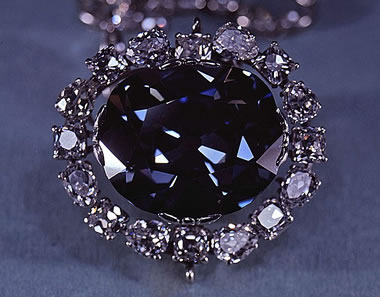
The Hope Diamond is the world's most famous blue diamond. It weighs 45.52 carats and is on display at the National Museum of Natural History in Washington, D.C. The Hope Diamond has a Fancy Dark grayish blue color. This photograph shows the depth of the blue color. Photograph from the archives of the Smithsonian Institution.
What Are Blue Diamonds?
Blue diamonds are diamonds with a blue bodycolor. Diamonds with a natural blue color are extremely rare, and they usually have very few mineral inclusions. [1] Their rare color and their high clarity make them extremely valuable gems.
Only a few mines produce blue diamonds, and those mines normally produce just a few blue diamonds in any given year. Their blue color is usually caused by trace amounts of boron in the diamond crystal lattice. The Hope diamond, in the collection of the Smithsonian Institution, is the most famous example of a blue diamond.
There are two other sources of blue diamonds: 1) lab-grown diamonds manufactured by people; and, 2) natural diamonds that have been treated to produce a blue color. These blue diamonds are not rare, and their value is only a small percentage of the prices paid for natural diamonds with a natural blue color.
Table of Contents
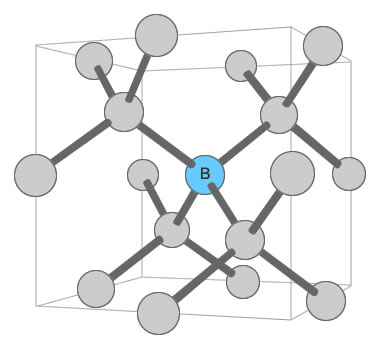
Boron Substitution in Diamond: When boron atoms substitute for carbon atoms in the diamond crystal lattice, it causes the diamond to selectively absorb red wavelengths of light and selectively transmit blue. The blue wavelengths are what reach the eye of the observer. Illustration modified after a Creative Commons image by Materialscientist.
Causes of Blue Color
A diamond composed entirely of carbon atoms, without impurities or defects will be colorless. Defects in the diamond crystal lattice are what cause colored diamonds. Causes of defects include: A) other elements substituting for carbon; B) vacancies in the diamond crystal lattice caused by missing carbon atoms; C) particles of non-diamond mineral matter included in the diamond.
Blue bodycolor in natural diamonds is most often caused when a small number of boron atoms substitute for carbon atoms in the diamond crystal lattice. This rarely occurs because boron is usually not present where natural diamonds form in the deep Earth environment. [1]
A large amount of boron is not required to produce a blue color in diamond. A boron concentration of only one part per million can be enough to produce a blue color. [2] The more boron that substitutes for carbon, the stronger the blue color. [3]
Boron is one of just a few elements that have atoms small enough to enter the diamond crystal lattice and substitute for a carbon atom. But the boron atom is not a perfect fit; it has one less available electron than carbon. When boron substitutes for carbon in the diamond crystal lattice, the electron deficiency causes a defect in the diamond crystal structure. This defect changes how light passes through the diamond crystal. It causes the diamond to selectively absorb light in the red portion of the visible spectrum and selectively transmit light in the blue portion of the visible spectrum. When the transmitted light reaches the eye of a human observer, the observer sees a blue diamond. [2]
The presence of boron in a diamond does not guarantee blue color. Small amounts of nitrogen in the diamond can produce defects that reduce the impact of boron-induced color. Diamonds with a rich blue color must contain very little nitrogen. Boron also does not guarantee a blue color. Blue color can also be associated with radiation exposure and hydrogen-related defects. [3]
Superdeep Origin of Blue Diamonds
For decades geologists have believed that virtually all diamonds found at Earth's surface formed from mantle materials at a depth of about 100 to 150 kilometers below Earth's surface. Then in 2018, a team of researchers surprised almost everyone when they found a number of blue diamonds that formed at pressures equivalent to depths of at least 410 to 660 kilometers and contained inclusions that could only have been derived from materials in the oceanic crust.
These diamonds were remarkable because: 1) They formed four times deeper than previously expected; 2) Inclusions in the diamonds were likely derived from crustal material that had subducted down to the transition zone of the lower mantle; and, 3) The boron that produced their blue color may have once been in the water of an ancient ocean! [1]
Although these ideas were surprising, they may provide a logical explanation as to why blue diamonds are found at only a small number of mines. These are mine locations that were positioned above slab of deeply subducted oceanic crust when material from that great depth ascended rapidly to Earth's surface - without melting.
Famous Blue Diamonds
The Okavango Blue
In April 2019, the Okavango Diamond Company, a company wholly-owned by the government of Botswana, presented the "Okavango Blue", a 20.46-carat blue diamond. The Gemological Institute of America graded the color of the gem as Fancy Deep blue, and its clarity as VVS.
Blue diamonds don't come much better than this!
The Okavango Blue was cut from a 41.11-carat rough diamond discovered at the Orapa Mine in Botswana. The Orapa Mine is the world's largest open-pit diamond mine on the basis of area. It is owned by Debswana, a joint venture of the government of Botswana and De Beers.

The Hope Diamond is the world's most famous blue diamond and probably the most famous diamond of any color. The specimen in the photo is a replica of the famous gem. A one-carat diamond is shown as a size comparison. Image copyright iStockphoto / DiamondGalaxy.
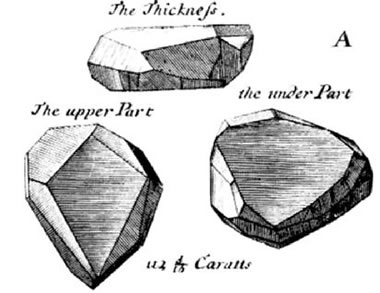
The Tavernier Blue was a crudely finished blue diamond purchased by Jean-Baptiste Tavernier in India in 1666. It was cut into the French Blue a few years later, and then cut into what would be called the Hope Diamond in about 1839. A public domain sketch made by Jean-Baptiste Tavernier.
The Hope Diamond
The Hope Diamond is a 45.52-carat antique cushion cut Fancy Dark grayish blue diamond owned by the Smithsonian Institution. It has been in their collection and on almost continuous public display since 1958. It has an estimated value of between $200 and $250 million. [4]
The diamond has always been a primary attraction at the Smithsonian. It is also the most popular exhibit of the Smithsonian's gem collection. That attention - and a storied history that can be traced back to 1653 - has made the Hope Diamond the best-known gemstone of all time.
Jean-Baptiste Tavernier, a French gem merchant, purchased the precursor stone of the Hope Diamond in India in 1666. This diamond, the 115.16-carat Tavernier Blue (see accompanying image), was sold to Louis XIV of France a few years later. Louis XIV had the diamond recut into the 68-carat French Blue, which was stolen and then thought to reappear as the 45.52-carat blue gem, which is now called the Hope Diamond, in 1839.
| Large blue diamonds of top color and quality are extremely rare. Sotheby's said: "Only 0.3% of all diamonds display a colour that is predominantly blue. Of this only a very small subsection qualifies as Fancy Vivid Blue." |
Blue Moon of Josephine
The Blue Moon of Josephine is a 12.03-carat, cushion-shape, Fancy Vivid blue diamond. It was sold at a Sotheby's auction in Hong Kong in 2015 for $48.4 million. It was cut from rough found at the Cullinan Mine in South Africa in 2014. [5]
David Bennett, head of the international jewelry division at Sotheby's, said the Blue Moon auction broke multiple records. It was "the most expensive diamond, regardless of colour, and the most expensive jewel ever sold at auction". [6]
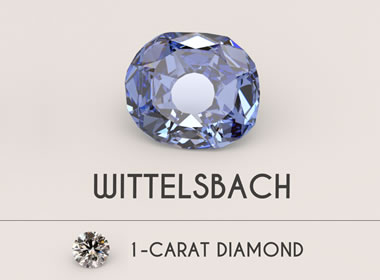
The Wittelsbach Diamond was a 35.56-carat Fancy Deep grayish blue diamond, believed to have been cut from rough mined at one of India's Kollur Mines in the 1600s. After passing through numerous owners, the Wittelsbach was purchased by Laurence Graff in 2008. Graff paid $23.4 million - the highest price ever paid for a diamond at auction at that time. Graff then shocked the diamond world by having the historic diamond recut to improve its cut, clarity, and color. The new Wittelsbach-Graff diamond was sold for a price suspected to have been over $80 million. The specimen in the photo is a replica of the famous gem. A one-carat diamond is shown as a size comparison. Image copyright iStockphoto / DiamondGalaxy.
The Wittelsbach / Wittelsbach-Graff Diamond
This blue diamond has one of the longest and most interesting histories in gemology. Known as Der Blaue Wittelsbacher, it was a faceted 35.56-carat grayish-blue diamond with wonderful clarity. The diamond is believed to have been cut from rough mined at one of the Kollur Mines of India in the 1600s. King Philip IV of Spain acquired it and gave it to his daughter Margarita Teresa in 1664. In her possession, and through marriage, it passed through the crown jewels of Austria and Bavaria. [7]
The Royal House of Wittelsbach offered the diamond for sale through Christie's of London in 1931, but it failed to reach its reserve price. [8] It later entered private ownership and its whereabouts were unknown for decades. Then in 2008, it was purchased by Laurence Graff, a billionaire diamond dealer, for $23.4 million - the highest price ever paid at auction for a diamond at that time.
Graff then shocked the diamond industry by having the diamond recut. He then renamed it the Wittelsbach-Graff Diamond. Those deeds earned Graff severe public criticism. One museum director said it was like “painting over a Rembrandt - in a reckless effort to increase its market value”. [9]
Cutting the gem removed 4.45 carats of weight. Cutting also: 1) improved its GIA color grade from Fancy Deep grayish blue to Fancy Deep blue, 2) improved its clarity grade from VS2 to internally flawless [10], 3) removed some chips and abrasions caused by wear, and, 4) helped Graff sell the then-named Wittelsbach-Graff Diamond for at least $80 million.
The grading certificate of the diamond is now exemplary, but a stone of great historic value was permanently changed. There are a diversity of opinions on the outcome, but Graff enjoyed an enormous profit.
Important Blue Diamonds from Golconda, India | ||
| Name | Polished Carat Weight | Color |
| Idol's Eye | 70.21 | Fancy Light blue |
| The Hope Diamond | 45.52 | Fancy Dark grayish blue |
| Mouawad Blue | 42.92 | Fancy blue |
| Crown of Charlemagne | 37.05 | Fancy Light blue |
| Sultan of Morocco | 35.27 | Fancy grayish blue |
| Wittelsbach-Graff | 31.06 | Fancy Deep blue |
| Brunswick Blue | 13.75 | Fancy blue |
| Diamonds listed above are from the Important Blue Diamonds of the World list compiled by Petra Diamonds. [11] | ||
Mines Known to Produce Blue Diamonds
Very few mines produce blue diamonds, and most of the important blue diamonds known to exist have come from just three locations: 1) a small area in India, 2) the Cullinan mine of South Africa, and 3) the Argyle mine of Western Australia.
Indian Mines
Diamonds with a natural blue color have been known since the 1600s. In those early days, all of the blue diamonds known to be produced were found in the Golconda Sultanate of India. That area is within the present-day Indian states of Telangana and Andhra Pradesh. The large pieces of blue rough used to cut the now-named Hope and Wittelsbach-Graff diamonds were found in the diamond mines of that area.
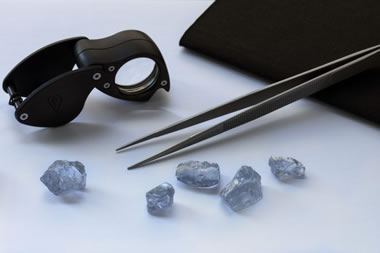
The Letlapa Tala Collection: These five rough blue diamonds were all found during a single week in September 2020 at the Cullinan Mine, owned by Petra Diamonds. They weigh 25.75, 21.25, 17.57, 11.42, and 9.61 carats. The Cullinan Mine is the world's most important source of blue diamonds. Photograph by Petra Diamonds.
Important Blue Diamonds from Cullinan Mine | ||
| Name | Polished Carat Weight | Color |
| The Blue Heart | 30.62 | Fancy Deep blue |
| Blue Lili | 30.06 | Fancy Intense blue |
| The Heart of Eternity | 27.64 | Fancy Vivid blue |
| Transvaal Blue | 25.00 | Fancy blue |
| Sam Abram Fancy Blue | 20.17 | Fancy Vivid blue |
| Graff Blue Ice Diamond | 20.02 | Fancy Deep blue |
| The Oppenheimer Blue | 14.62 | Fancy Vivid blue |
| The Blue Empress | 14.00 | Fancy blue |
| The Begum Blue | 13.78 | Fancy Deep blue |
| The Blue | 13.22 | Fancy Vivid blue |
| The Blue Magic | 12.02 | Fancy Vivid blue |
| The Blue Moon of Josephine | 12.00 | Fancy Vivid blue |
| Bulgari Blue | 10.95 | Fancy Vivid blue |
| The Star of Josephine | 7.03 | Fancy Vivid blue |
| Diamonds listed above are from the Important Blue Diamonds of the World list compiled by Petra Diamonds. [11] | ||
The Cullinan Mine (formerly Premier Mine)
The world's most significant source of blue diamonds has been the Cullinan Diamond Mine in South Africa. The mine began producing diamonds in 1902 under the direction of Thomas Cullinan, who discovered the diamond field in which the mine is located. At that time it was known as the Premier Mine.
Since then the Cullinan Mine has produced most of the world's blue diamonds, the world's largest rough diamond, the world's largest faceted diamond, and a significant share of the world's diamonds weighing over 100 carats.
The mine was originally known from its founding in 1902 as the Premier Mine. Later, under De Beers ownership, the name was changed to the Cullinan Mine in 2003. The mine is currently owned and operated by Petra Diamonds. Most of the rough blue diamonds of 20 carats or more produced within the last 100 years have been found at Cullinan.
The Argyle Mine
The Argyle Mine, owned by Rio Tinto and located in Western Australia, has been the largest diamond-producing mine in the world on the basis of volume. It is best known for producing a small but steady supply of red and pink diamonds and an abundance of brown diamonds. Argyle produces a very small amount of blue diamonds. In 2009 they offered their “Once in a Blue Moon” collection for sale. It included 287 carats of blue and violet diamonds that the company had accumulated over a span of several years.
Other Sources of Large Blue Diamonds
Two significant blue diamonds from other sources include: The Copenhagen Blue, a 45.85-carat Fancy blue, was cut from rough produced from the Jagersfontein Mine of South Africa; and, the Graff Imperial Blue, a 101.5-carat Fancy Light blue, was cut from rough produced from the Aredor Mine of Guinea.
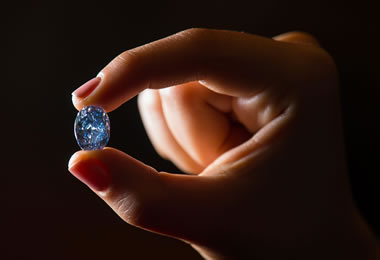
Millennium Jewel: The Millennium Jewel is an internally flawless, blue, oval-shaped diamond, weighing 10.10 carats. Its rough was discovered at the De Beers Millennium Mine. The faceted stone, shown here, was sold for $32 million at Sotheby's Hong Kong Magnificent Jewels and Jadeite Sale on April 5, 2016. It is one of the world's most valuable blue diamonds. Photo by Dominic Lipinski / Alamy Stock Photo.
Blue Diamonds Sold at Auction | |||
| Name | Polished Carat Weight | Color | Price |
| Oppenheimer Blue | 14.62 | Fancy Vivid blue | $57,231,903 |
| Blue Moon of Josephine | 12.03 | Fancy Vivid blue | $48,468,158 |
| Memory of Autumn Leaves (Apollo) | 14.54 | Fancy Vivid blue | $42,087,302 |
| The Zoe Diamond | 9.75 | Fancy Vivid blue | $32,645,000 |
| De Beers Millennium Jewel 4 | 10.1 | Fancy Vivid blue | $32,013,223 |
| The Blue | 13.22 | Fancy Vivid blue | $24,202,829 |
| The Sky Blue Diamond | 8.01 | Fancy Vivid blue | $17,074,168 |
| The Bvlgari Blue | 10.95 | Fancy Vivid blue | $15,762,500 |
| The Ai Diamond | 5.0 | Fancy Vivid blue | $13,873,082 |
| blue diamond ring | 13.39 | Fancy Intense blue | $9,288,823 |
| The Farnese Blue | 6.16 | Fancy Dark gray-blue | $6,713,837 |
| blue diamond ring | 3.47 | Fancy Intense blue | $6,663,300 |
| Etcetera ring | 3.37 | Fancy Intense blue | $2,770,856 |
| green-blue diamond ring | 1.11 | Fancy Vivid green-blue | $415,111 |
| blue and colored diamond ring | 2.11 | Fancy Vivid blue | $379,393 |
| greenish blue diamond & pearl ring | 1.62 | Fancy Vivid greenish blue | $350,880 |
| blue diamond ring | 0.87 | Fancy blue | $231,203 |
| Diamonds listed above were sold between the years 2003-2018. Click on the name of the diamond to see photos and details. | |||
Blue Diamond Prices
The most valuable blue diamonds are natural diamonds with a pleasing pure blue color that is uniformly distributed through the gem. These diamonds are extremely rare and can sell for prices that often exceed a million dollars per carat. The accompanying table shows recent auction prices for some exceptional blue diamonds.
Natural blue diamonds are often modified by a secondary color such as green or gray. These greenish blue and grayish blue diamonds are also rare, but generally sell for prices that are less than the more preferred pure blue color. Natural blue diamonds with a faint or a light blue color will also sell for lower prices. Many people enjoy these diamonds and are happy to buy them at these more affordable prices.
Treated Blue Diamonds
People have discovered ways to produce blue diamonds by treating diamonds that have a less valuable color. Irradiation and high-pressure high-temperature treatments are both used to produce blue color in diamonds. Any time a diamond's color is modified in this way, the seller should always offer it for sale as a diamond with treated color. The seller should also disclose the type of treatment and if the diamond requires special care. [12]
Diamonds with a color produced by treatment should not have a spectacular price tag. Instead, at most, they should sell for a small premium over the cost of the same diamond without treatment. Treatment does not make the diamond "rare". It is simply a service performed to alter the diamond's color. Diamonds with a color produced by treatment should always be sold with that treatment disclosed and with the customer understanding what is being purchased.
Another treatment used to produce blue color in diamonds is coating. A thin surface coating of colorful but transparent material is applied to the surface of the diamond. Coatings of any material other than lab-grown diamond will be less durable than diamond. If the diamond is set in jewelry that is worn, it will show signs of abrasion over time. The cost of a coated diamond should be no more than a small premium over the cost of the same diamond without treatment.
| Blue Diamond Information |
|
[1] Where Do Blue Diamonds Come From? by Evan M. Smith, article on the Gemological Institute of America website, last accessed July 2022.
[2] An Update on Color in Gems. Part 3: Colors Caused by Band Gaps and Physical Phenomena: by Emmanuel Fritsch and George R. Rossman; an article in Gems & Gemology, Summer 1988, pages 81 to 102. [3] Natural-Color Blue, Gray, and Violet Diamonds: Allure of the Deep: by Sally Eaton-Magaña, Christopher M. Breeding, and James E. Shigley; an article in Gems & Gemology, Summer 2018, pages 112 to 131. [4] Hope Diamond: Article on Wikipedia.org, last accessed July 2022. [5] The Rarest of the Rare: Multimillion-Dollar Blue Diamonds: by Sotheby's, article on the Sotheby's website, December 7, 2018. Last accessed July 2022. [6] Billionaire buys 7-year-old daughter Blue Moon diamond for record $48m: by Agence France-Presse, article on The Guardian website, November 12, 2015. Last accessed July 2022. [7] Out of the Blue, Prestige and Riches: by Guy Trebay, article on The New York Times website, January 6, 2010. Last accessed July 2022. [8] Worn by royalty, sold by Christie's: by Vincent Meylan, article on the Christie's website, November 4, 2016. Last accessed July 2022. [9] Graff accused of 'painting over a Rembrandt' by gemologists: by Laura Roberts, article on the Telegraph website, January 29, 2010. Last accessed July 2022. [10] The Wittelsbach; All tarted up and ready to sell: by Richard W. Wise, post on The GemWise Blog, 2010. Archived copy, accessed July 2022. [11] Important Blue Diamonds of the World: List compiled by Petra Diamonds, .pdf document on the PetraDiamonds.com website, July 2017. Last accessed July 2022. [12] Changing a Diamond's Color: Article on the Gemological Institute of America website, last accessed July 2022. |
Laboratory-Grown Blue Diamonds
The makers of laboratory-grown diamond have been producing blue material for over a decade. They do this by introducing boron into the diamond-growing environment. They also do it using post-growth irradiation or high-pressure high-temperature treatments. Lab-grown diamonds with a blue color are not rarities, and they are usually sold for prices that are lower than natural diamonds of similar size and clarity on the D-to-Z color scale.
One of the most significant events in the diamond market occurred on May 29, 2018 when De Beers announced their Lightbox Jewelry Collection. De Beers has a long history as a miner and source of unpolished natural diamonds for the gem and jewelry trade. However, De Beers is also the majority shareholder of Element Six, a company producing synthetic diamond and other supermaterials for industrial use.
De Beers announced and began selling laboratory-grown diamonds in jewelry for the surprising price of only $800 per carat, plus a reasonable additional amount for the metal settings. For that price they offered ungraded lab-grown diamonds in "white", pink and blue colors. Their price was surprisingly lower than any other maker of lab-grown diamonds. The price was only 10% to 50% of what every other lab-grown diamond seller was charging at that time. Some people in the diamond industry speculated that the Lightbox price was below the cost of production. De Beers began construction of a building that would house the machines that would produce diamonds for Lightbox Jewelry in Gresham, Oregon. They expect to produce 500,000 carats per year in 2020.
The Lightbox product line, and its pricing in particular, caught much of the diamond industry by surprise. The low prices announced by De Beers will place pressure on other synthetic diamond producers. The upside of Lightbox belongs to the consumer, because now almost anyone will be able to purchase a laboratory-grown diamond at a price that they can afford. It also provides an alternative, attractive, and low-cost product for anyone who wants a pair of natural blue diamond earrings but can't afford them.
| More Diamonds |
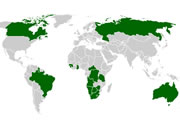 |
Diamond Production |
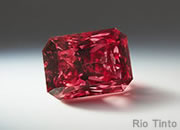 |
Red Diamonds |
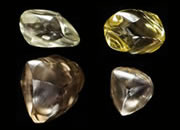 |
US Diamond Mines |
 |
Diamonds Do Not Form From Coal |
 |
Diamond |
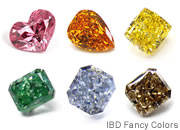 |
Colored Diamonds |
 |
Canadian Diamond Mines |
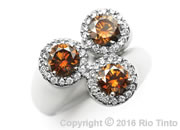 |
Brown Diamonds |

Find Other Topics on Geology.com:

|

| ||

|

| ||

|

| ||

|

|

